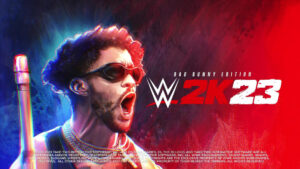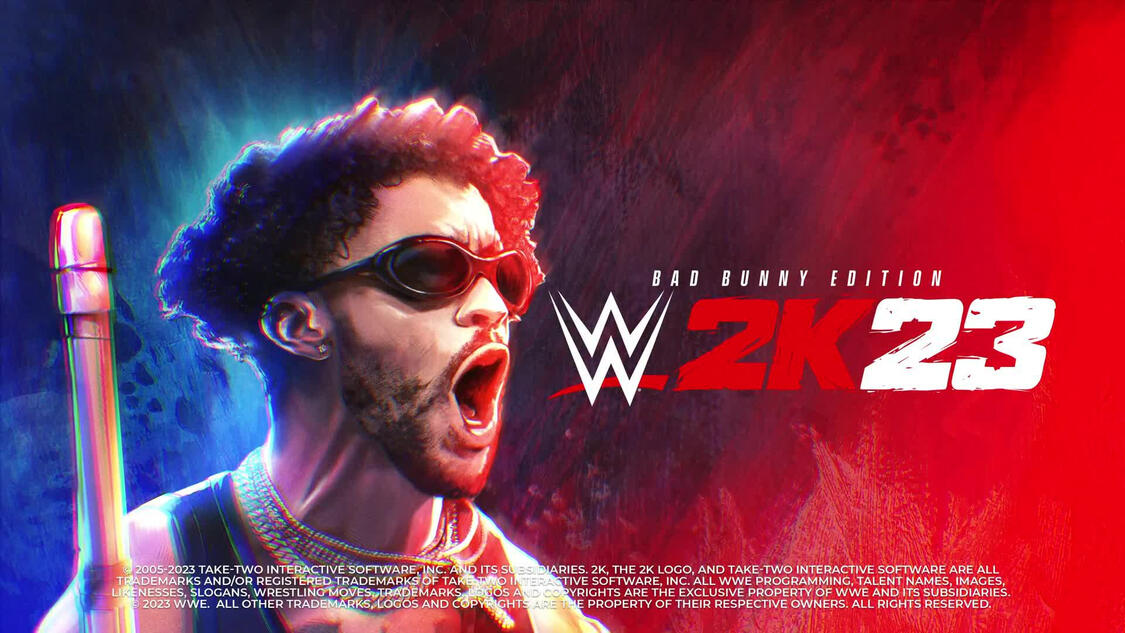Introduction
During in-class discussions of Benito’s lyrics, music, videos, and general elements of his identity which comprise his image, a common theme that has arised is his activism for the queer community and embrace of gender fluidity in a genre where homophobia and toxic masculinity have previously been normalized (Avila). He has built this image of rebellion against the status quo with his motto of “yo hago lo que me da la gana”, and it is part of what has established him as a political icon amongst fans (Venkataramanan). Given this image, it was surprising to learn of his lifelong passion and interest in the world of professional wrestling, an institution which has long affirmed rigid boundaries on masculinity (Mazer 105). Indeed, he has two songs with professional wrestlers, eight appearances on WWE (Ramft), a feature in Cassandro, a movie about a queer Lucha Libre wrestlers rise to stardom (Ramirez), and is even featured in the cover of W2K23, the WWE video game.

Cover of W2K23, a popular WWE wrestling video game.
One framework which has been presented by scholar of professional wrestling Sharon Mazer has been to analyze the dynamic between wrestlers through the scope of masculinities, noting that wrestling is a performance in which two wrestlers are both competing to fight emasculation and achieve the ideal of a “real man” (Mazer, 90). I argue that this framework is restrictive to white forms of masculinity and the way the ideals of a “real man” manifest in Benito’s involvement in the wrestling world are more firmly aligned with latino ideals of masculinity such as machismo present in Lucha Libre. The dynamic between the two fighters should be analyzed by considering the intersection of masculinity, culture, and colonial resistance. To make this argument I will be looking at Benito’s most recent appearance on WWE: Backlash 2023, where he wrestles Damien Priest, a wrestler also raised in Vega Baja, at the Coliseo de Puerto Rico in San Juan.
WWE, Machismo, and Lucha Libre
What’s helpful in Mazer’s framework is the understanding that WWE is a performance where the audience indirectly learns what masculinity is supposed to look like, not only based on the physique and attire of the wrestler, but factors like their role in a broader WWE narrative, identity outside the ring, if they cheated to win, etc. These elements serve to inform an audience how the epitome of masculinity, specifically white masculinity, should manifest in contexts outside the ring. In broadly analyzing WWE, an often underlying assumption that is made is that wrestling is “right-wing and inherently American” (Smith). This marks one of the primary differences between WWE and lucha libre. The difference in culture carries with it different ideals of masculinity, where machismo is most aptly reflected in the dynamic between Priest and Benito.
To clarify their differences, when Javier Pereda writes about Lucha Libre he emphasizes the deep rooted ties to culture through beliefs and traditions, which are often reflected in the design of the luchador’s mask and in their performance (Pereda 1). Further, in Lucha Libre there are no narratives—universally the dynamic between the fighters is always one of good (Tecnicos) vs evil (Rudos) (Pereda 3). Lastly, Pereda argues that this constant universal dynamic creates a metanarrative of hyperrealism: “Based on the meta-narrative presented by Lucha Libre, the audience believe that the opponent genuinely hate each other, generating a hyperreal response from it, with real emotions”(Pereda 3). Further, the representation of a machismo form of masculinity contributes to the hyperrealism of Lucha Libre.
Puerto Rico vs. The World
The dynamic that ensues between Benito and his opponent Damien Priest follows the Tecnicos vs Rudos framework given that Benito is depicted as the hometown hero while Priest is painted as representative of the WWE institution as a whole. When the wrestlers are introduced, one cannot deduce that they both hail from Vega Baja, as only Benito’s hometown is mentioned. Furthermore, although Benito has enough WWE appearances to fit into one of the larger narratives of allegiances and rivalries that exist within WWE, this part is omitted during his introduction. Paying close attention to audience reception during each introduction, it can clearly be deduced that Benito is perceived as the hero and Priest the villain.
First introduced is Priest, who gets a short introduction and little audience reception. Take note of the somber music in the background, the close up shots of his angry face, and the banging of his chest with his arms, all deliberate elements of the production meant to characterize Priest as the villain.
Contrary to the ominous entrance of Priest, Bad Bunny makes an entrance to his hit single “Chambea.” As Benito enters he clearly is not angry, but appears to have a serious facial expression and motivated demeanor. Unlike Priest, fans from the stands extend their hands for high fives and pyrotechnics go off as the commentators announce he is from Vega Baja. It is fitting he holds a wooden pole wrapped in the Puerto Rican flag as he enters the ring, because the dynamic of the fight seems to be representative of a form of resistance to American institutions taking over an already existing form of wrestling (Lucha Libre) because of the monopoly and profit incentive of WWE (Smith).
The fight between Priest and Bad Bunny is more than a performance against emasculation as Mazer originally suggests, rather, the match embodies the cultural values associated with a machismo male identity. From the introductions, we see that Priest is deliberately stripped of a Puerto Rican identity. With regard to Bad Bunny, as Pedro Saez notes in his 2009 paper on ideologies of machismo, this latino ideal of masculinity can be interpreted “as representing a protector, provider, and authority figure” (Saez, 117). In this fight, this is exactly the role that Bad Bunny fills—his stardom, cultural ties, and Yo soy de P F*N R energy and pride for Puerto Rico uniquely situates him to hold the role as the protector and certainly an authority figure of Puerto Rico that Saez finds is representative of the machismo ideology, and introduces an intersectionality between culture and masculinity that is not reproduced in WWE. When the dynamics of the fight are seen through this lens, the fight evolves from Bad Bunny vs. Damian Priest into Puerto Rico vs. a dominant “right-wing and inherently American” institution (Smith).
Conclusion
Looking at Bad Bunny’s image from a birds eye view, it’s important to recognize that he does not serve in a strict capacity to be an advocate for the queer community or have a responsibility to challenge gender binaries. In fact, he has fallen into controversy for moves like using an ex-girlfriends audio sample in many songs and not crediting her for it (Couto). Though it can be easier to amplify his advocacy in an analysis of his image, Benito himself is explicit about the role he plays as a political figure and performance artist: “yo hago lo que me da la gana”. In many ways, this seems to work as a personal skirting of responsibilities that come with the stardom that he’s achieved, yet, it is this attitude that has brought him into the spotlight to begin with.
When I started this project, I was too focused on putting his image as an advocate in contention with the world of professional wrestling, but it slowly evolved into an exploration of ties between culture, masculinity, and colonial resistance that are not considered in the dynamics between wrestlers in WWE. Via this framework, the answer to why he would invest himself in an institution like wrestling becomes a lot more clear; there is a history of American institutions—now sometimes not even hiding under the guise of good intention—bringing more harm than good to the island.
In my exploration, I found that scholars tend to highlight the absurdity of the firm definitions of masculinity that both WWE and Lucha Libre provide for the audience, but as my analysis shows there is actually some powerful activism in what came from Benito aligning with the ideals of machismo. The question that arose which I hope other scholars of Bad Bunny can explore is whether this dynamic of advocacy as a product of machismo manifests only in his performances as a wrestler, or in other forms of his media as well?
Works Cited
Avila, Pamela, and David Oliver. “How Bad Bunny’s Gender Fluidity Is Shaking up a Genre, Empowering the Latino LGBTQ Community.” USA Today, Gannett Satellite Information Network, 28 Aug. 2023, www.usatoday.com/story/entertainment/music/2023/03/30/bad-bunny-latinx-lgbtq-community/11493479002/.
Couto, Sarah Do. “Bad Bunny Sued for $40m by Ex-Girlfriend over Song Sample – National.” Global News, Global News, 21 Mar. 2023, globalnews.ca/news/9567076/bad-bunny-lawsuit-ex-girlfriend-voice-song/.
MAZER, SHARON. “Real Men Don’t Wear Shirts.” Professional Wrestling: Sport and Spectacle, Second Edition, 2nd ed., University Press of Mississippi, 2020, pp. 85–106. JSTOR, https://doi.org/10.2307/j.ctvx5w9pw.8. Accessed 13 Dec. 2024.
Pereda, Javier. “The Role of Lucha Libre in the Construction of Mexican Male Identity.” Journal of the MeCCSA Postgraduate Network, 2011, ojs.meccsa.org.uk/index.php/netknow/article/view/68/68.
Ramirez, Cindy. “‘Cassandro’ Film Depicts Trailblazing Borderland Luchador.” El Paso Matters, 13 Sept. 2023, elpasomatters.org/2023/09/12/cassandro-exotico-movie-listing-el-paso-saul-armendariz-gael-garcia-bernal/.
Ranft, Shaun. “WWE Promoting Live Appearance by Bad Bunny for next Monday’s Raw.” Wrestling Inc., Wrestling Inc., 18 Apr. 2023, www.wrestlinginc.com/1260526/wwe-promoting-live-appearance-by-bad-bunny-for-next-mondays-raw/.
Saez, Pedro A., et al. “Factors influencing masculinity ideology among Latino men.” The Journal of Men’s Studies, vol. 17, no. 2, Mar. 2010, pp. 116–128, https://doi.org/10.3149/jms.1702.116.
Smith, Nadine. “The Misunderstood History of American Wrestling.” The Nation, 11 Nov. 2023, www.thenation.com/article/culture/ringmaster-wwe-vince-mcmahon/.
Venkataramanan, Meena. “For Bad Bunny’s Fans, He’s More than a Global Superstar. He’s a Political Icon.” Washington Post, 19 Oct. 2022, www.washingtonpost.com/nation/2022/10/19/bad-bunny-political-activism/.
WWE. “FULL MATCH: Bad Bunny vs. Damian Priest — San Juan Street Fight: Backlash 2023.” YouTube, YouTube, 20 Sept. 2024, www.youtube.com/watch?v=TVLoshFEow4&t=189s.
